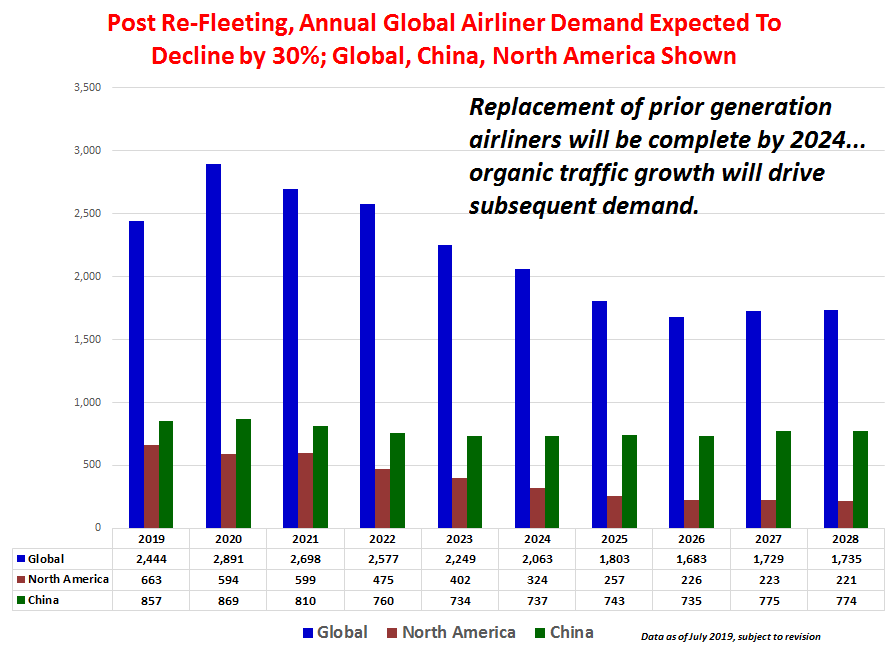Before We Start This Week…
Jumping Into The Future…
At the International Aviation Forecast Summit, we have the future covered…
 Boom Supersonic will be presenting its views of the near future with its 70-75 seat Overture supersonic jetliner, which is on the near-horizon for operation ion the mid-2020s. It will engender changes in the way global airlines operate.
Boom Supersonic will be presenting its views of the near future with its 70-75 seat Overture supersonic jetliner, which is on the near-horizon for operation ion the mid-2020s. It will engender changes in the way global airlines operate.
The supersonic demonstrator is well down the production process at the company’s Denver facility.
Now, How About Hypersonic… Further down the time line, there is also the concept of hypersonic airliners.
This is the reason the IAFS is excited to welcome Hermeus Corporation, which will be outlining the potential and future of airliners that can fly 5X the speed of sound… whole new technologies and a really over the horizon view of the future.
It’s another reason that aviation leaders will be in Las Vegas August 25-27…it’s alwasys cutting-edge…. just take a gander at the agenda – no other event exposes attendees to this number and level of aviation leaders.
Join us – and get real forecasts of the exciting and very different future we’ll be seeing in the coming decade!
_____________________
The Global Airliner Industry –
New Changes At The Gate – And At The Orderbook
There’s been lots of speculation regarding how the 737 MAX grounding might be the start of opportunities for other manufacturers.
China Not In The Play. One trendy suggestion commonly mentioned is China, which has the 76-seat ARJ-21 and the 150+ seat C919 airliners on the deck.
The only problem is that neither of these platforms have a snowball’s chance in the South China Sea of being globally-competitive.
The challenge is breaking into the global airliner business with products that are, at best, just more-of-the-same. In fact, of the 705 orders for the C919, the majority are from leasing and finance companies, and all but a handful are from companies inside China.
In the past 40 years, China has successfully wowed the world by establishing itself as a leader or near-leader in a whole range of industries. Airliners, unfortunately, is not one of them.
But beyond this, there is one other factor that’s been unnoticed in regard to the global commercial airliner business…
It’s not a long-term growth business that is attractive to new entrants.
Manufacturer Challenge: Carefully Plan Production Rates. In fact, by 2028, our forecasts indicate that the annual global demand for turbojet airliners will decline by more than 40%.
It’s still going to be a robust business. Even with this decline, there’s still the better part of 1,800 airliners forecast to be annually needed. But, given the amount of investment and capital necessary to barge into this sector, it’s probably one left to the current players.
Replacement Demand v Growth Demand. Here’s the issue: Today, the global airline industry is in the midst of ordering airliners based on re-fleeting. They want new-generation Airbus and Boeing and Embraer aircraft to replace older ones. This part of the equation will take another 4-5 years.
And when that’s completed, the annual demand will settle into one driven mostly by changes in passenger growth. And even here. the traditional methodologies of using economic and demographic metrics are increasingly problematic. New entrant carriers – particularly in Asia – are changing how airliners are used – spiking the market.
The Future – It’s A Jump Ball. The Boyd Group International Aviation Forecast Summit will be covering this, with our Global Airliner Trend & Demand Forecast, projecting out 2019 through 2028.
And we’re honored to also have the forecasts of Boeing, Airbus and Embraer at the IAFS™, too, which may well counter these projections, and will certainly bring wider perspectives. It’s what the IAFS™ is all about – exploration of new perspectives.
Supersonic? Yes… Another near-term disruptive wild card in this area is Boom Supersonic, which is producing a 70-75 seat airliner that is projected to have the economics to profitably carry business-class passengers at today’s fares, and will be in operation roughly in the mid-2020s.
This machine could literally clear out the front ends of existing wide-body international flights, thereby allowing more cabin real estate for “premium economy” (nee, “business class” circa 1985), which is the next frontier in revenue generation for major global carriers.
Back To The 1980s? Well, Maybe Outside of North America. One other consideration that runs counter to ambient thinking, not to mention demonstrable fleet history, is the potential future demand for next-generation turboprops.
In the U.S., they are DOA at the gate. But in other areas of the globe, 50-80 seat turboprops with the performance capabilities to meet the needs of rural growth regions, such as in Asia and particularly China, may have a new set of market potentialities.
Join The Exploration At the IAFS™. Lots of changes coming in the next ten years. At the International Aviation Forecast Summit, airliner and fleet issues are just a part of the exploration.
Furthermore, the airline and industry CEOs and senior executives at the Summit deliver what they believe is important to the future – and that means perspectives that no other aviation event can get close to.
If you haven’t registered yet, do so now by clicking here.
